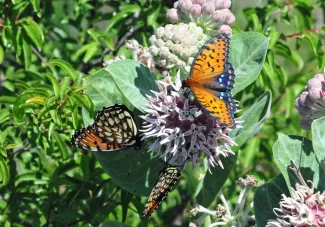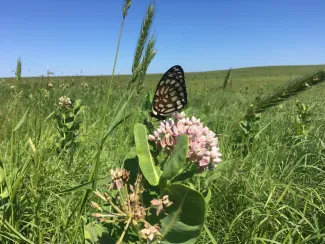In 2019, a survey team from Oklahoma State University embarked on a quest to find a rare Oklahoma butterfly, the regal fritillary. Over the course of three years, the team conducted more than 450 surveys across an eight-county area in northeastern Oklahoma’s tallgrass prairie region and found nine individuals.

Regal fritillaries on a milkweed plant.
“Prior to this survey, the regal fritillary had been documented in Oklahoma only at The Nature Conservancy’s Tallgrass Prairie Preserve and seven other locations during the past 50 years, and no systematic effort had been made to quantify the butterfly’s distribution in our state,” said Mark Howery, senior wildlife biologist for the Wildlife Department. “Although the survey turned up only a handful of individual regal fritillaries, it was immensely helpful because it validated what many biologists had suspected.”
The butterfly was petitioned for listing under the Endangered Species Act in 2013 and a decision is expected from the U.S. Fish and Wildlife Service in 2023-2024. Oklahoma is one of 13 states where regal fritillary surveys have been conducted to better understand the distribution and ecology of this specialized butterfly.
“The results of these surveys have been shared with the U.S. Fish and Wildlife Service and will contribute to their Species Status Assessment that will inform their upcoming listing decision.”
Male and female regal fritillaries overwinter as recently hatched larvae that grow in the spring, envelop in chrysalises for a few weeks, and emerge as butterflies in late May and early June. Though the males typically die by mid-July, the females may persist until early October and lay eggs on dead leaves near the caterpillar’s host plant. At least eight species of violet have been recognized as host plants across the butterfly’s range, six of which have been documented in Oklahoma. Even so, these violets naturally occur at significantly lower densities in the Southern Plains than in the Northern Great Plains where the regal fritillary is much more common.
“This study helps reaffirm Oklahoma as a southern periphery state for the species,” Howery said. “Regal fritillaries have previously been documented in five northeastern Oklahoma counties, but there’s no evidence that Oklahoma supports a breeding population outside of the Flint Hills of Osage County. Most of Oklahoma’s historic records are likely to be of vagrant individuals originating from prairies in Kansas and Missouri.”

Regal fritillary caterpillars rely on violets, but the adults will nectar from a variety of blooms, including milkweed.
In addition to recording the presence and absence of regal fritillaries and the occurrence of its host plants, the survey team also recorded the presence of five other rare prairie butterfly species, including the Diana fritillary, great spangled fritillary, and Arogos skipper, as well as the familiar monarch, which is a species that appears to be in decline. In total, 489 individual butterflies of seven species were documented during the study.
Butterfly surveys were funded by State Wildlife Grant F18AF00933 and Oklahoma State University.